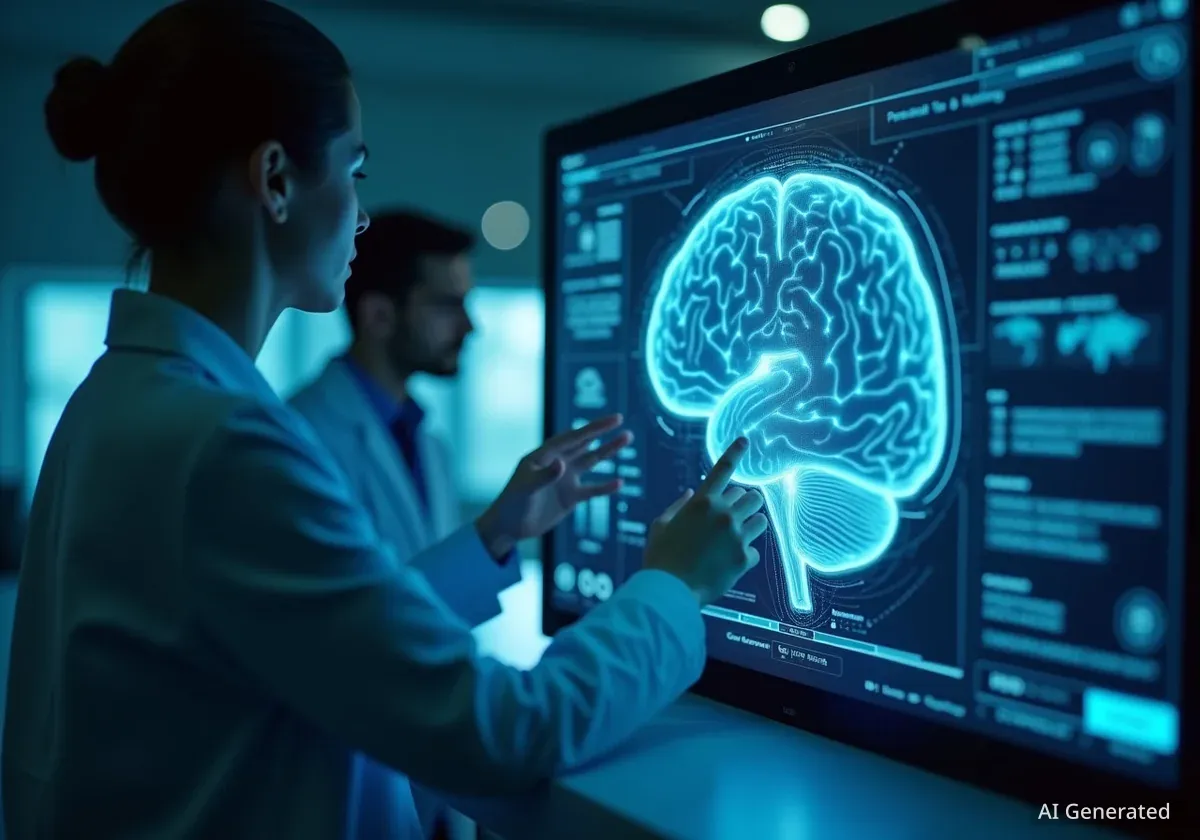A new generation of technology companies is developing brain-computer interfaces (BCIs), devices that create a direct link between the human brain and digital systems. Firms like Elon Musk's Neuralink and competitors including Precision Neuroscience and Science Corporation are pioneering methods to interpret and influence neural activity, with initial applications focused on major medical challenges.
These technologies operate by detecting the electrical signals generated by the brain's 86 billion neurons. By decoding these signals, BCIs aim to restore communication for paralyzed individuals, treat neurological disorders, and potentially augment human capabilities by merging biological intelligence with artificial intelligence.
Key Takeaways
- Brain-computer interfaces (BCIs) are being developed by several competing startups to link the human brain directly with computers.
- The primary approaches are invasive (requiring surgery) and non-invasive (using external sensors), each with distinct trade-offs.
- Companies like Neuralink use penetrating electrodes, while others like Precision Neuroscience are developing less damaging surface arrays.
- Initial BCI applications focus on medical treatments for paralysis, blindness, and neurological conditions like depression and Parkinson's disease.
- Future applications could include direct thought-to-text communication, skill acquisition, and enhanced human-AI integration.
The Two Paths of Brain-Computer Interfaces
The field of brain-computer interfaces is fundamentally split into two main categories: invasive and non-invasive. The choice between these methods defines a company's entire technological and medical strategy.
Invasive BCI Technology
Invasive approaches involve surgically placing electronic devices directly onto or into the brain. This technique provides the highest quality of neural data because the sensors are in close proximity to the neurons they are monitoring.
Companies pursuing this path argue that direct contact is necessary for the most complex applications, such as high-fidelity control of prosthetic limbs or detailed thought-to-text translation. The primary drawback is the requirement for surgery, which carries inherent risks and presents a significant barrier to widespread adoption.
Non-Invasive BCI Technology
Non-invasive methods use sensors that are placed on the outside of the head, such as in a cap or headband. These devices, which often use electroencephalography (EEG) to measure electrical activity, do not require any medical procedures.
The main advantage is accessibility and safety, making them suitable for consumer applications. Historically, the challenge has been lower signal quality. However, recent advancements in sensor technology and AI-powered data analysis are making it possible to extract more meaningful information from non-invasive readings, narrowing the performance gap.
Understanding Brain Signals
The human brain functions as a vast biological network. Its approximately 86 billion neurons communicate using tiny electrical impulses. Every thought, movement, or sensation corresponds to a specific pattern of these signals. BCI technology is built on the ability to detect and interpret these electrical patterns. Whether through an implanted electrode or an external sensor, the goal is to translate the brain's electrical language into commands a computer can understand.
A Landscape of Competing Startups
Several well-funded companies are racing to develop the first commercially successful invasive BCI. While sharing a common goal, their methods differ significantly, particularly concerning the level of invasiveness and potential for long-term brain health.
The Legacy of the Utah Array
Early BCI research relied on the "Utah array," a device developed in the 1980s. It consists of 100 rigid needles that penetrate the brain tissue to record neural signals. While groundbreaking, this design has a significant limitation known as the "butcher ratio"—it damages a large number of neurons relative to the number it can record from. Early BCI companies like Blackrock Neurotech were based on this technology.
Synchron's Vascular Approach
Founded in 2012, Synchron developed a less invasive surgical technique. Their device is inserted into a blood vessel and guided to a position adjacent to the brain, avoiding direct penetration of brain tissue. This method, similar to implanting a cardiac stent, is safer and has a butcher ratio of zero.
"For a medical device, safety often implies minimal invasiveness," said Ben Rapoport, a neurosurgeon and cofounder of Precision Neuroscience, in a 2024 interview, highlighting the industry's shift away from damaging methods.
Synchron's device has received FDA clearance for clinical trials and has been implanted in several patients. However, its position within a blood vessel limits its signal granularity and bandwidth compared to competitors. The device currently has 16 electrodes and is focused on enabling simple computer interactions, like clicking.
Neuralink and Flexible Electrodes
Neuralink, founded by Elon Musk in 2016, aimed to improve upon the Utah array by using flexible, ultra-thin threads instead of rigid needles. Each thread, thinner than a human hair, contains 16 electrodes. The company's current device has 1,024 electrodes, or channels, offering significantly higher bandwidth than Synchron's.
The company also developed a surgical robot to automate the implantation process. Neuralink's first human trial participant, Noland Arbaugh, demonstrated the ability to control a computer cursor and play chess with his mind. Despite this success, the company reported that many of the device's threads later retracted from the brain, raising questions about the long-term stability of this approach.
BCI Bandwidth Comparison
- Synchron: 16 electrodes
- Original Utah Array: 96 electrodes
- Neuralink: 1,024 electrodes
- Precision Neuroscience: 1,024 electrodes
Higher electrode counts allow for a richer exchange of information between the brain and a computer, enabling more complex tasks.
The Next Generation of Invasive BCI
Recognizing the limitations of penetrating electrodes, a new wave of startups, some founded by former Neuralink employees, is exploring alternative invasive techniques that prioritize brain safety without sacrificing performance.
Precision Neuroscience and Surface Arrays
Precision Neuroscience, co-founded by former Neuralink member Ben Rapoport, uses an approach called electrocorticography (ECoG). Their device is a thin, flexible array of electrodes that sits on the surface of the brain without penetrating the tissue.
This method eliminates the risk of damaging neurons from insertion. The company's array contains 1,024 electrodes, matching Neuralink's bandwidth. Research from labs like Dr. Edward Chang's at UCSF has shown that ECoG can support highly complex tasks, including decoding a paralyzed patient's thoughts into text at a speed of 78 words per minute—a capability that surpasses what has been publicly demonstrated with penetrating electrodes.
Science Corp and Biohybrid Interfaces
Science Corporation, founded in 2021 by another Neuralink cofounder, Max Hodak, is pursuing one of the most ambitious concepts in the field: a biohybrid neural interface. This technology combines engineered hardware with living cells.
The process involves growing biological neurons in a lab and embedding them into an electronic device. When this system is implanted, the lab-grown neurons naturally grow and form connections with the patient's brain. This biological integration could create an incredibly high-bandwidth connection—potentially billions of connections—while avoiding the damage caused by inserting foreign materials into brain tissue.
While still in early development, this biohybrid approach represents a potential long-term solution that leverages the brain's own mechanisms for creating connections.
The Future Impact of Brain-Computer Interfaces
The initial and most immediate impact of BCI technology will be in medicine. For millions of people with paralysis from strokes, spinal cord injuries, or ALS, these devices offer the possibility of restored communication and interaction with the world.
Beyond paralysis, BCI could offer new treatments for a range of conditions:
- Depression
- Obsessive-compulsive disorder (OCD)
- Chronic pain
- Epilepsy
- Parkinson’s disease
As the technology matures and potentially becomes available to the general public, the implications could be transformative. Future possibilities include direct brain-to-brain communication, instant skill acquisition by reinforcing neural pathways, and a seamless integration of human and artificial intelligence, where AI acts as a natural extension of a person's own cognitive processes. While these scenarios remain distant, the foundational work being done today is paving the way for a future where the line between the human mind and technology becomes increasingly blurred.





